In today's digital age, a strong online presence is essential for the success of any restaurant.
With over 90% of customers relying on the internet to discover new dining experiences, making your establishment stand out is not just an option—it's a necessity.
In this article, we’ll explore seven practical tips to not only enhance your online visibility but also leave a lasting impression.
From crafting a distinctive brand identity to leveraging the potential of online advertising, these strategies will help you establish a formidable online presence for your restaurant.
Develop a Brand Identity
Developing a robust brand identity for your restaurant and ensuring its consistent presentation across all online platforms, from your website to social media profiles, is essential for making your establishment stand out among competitors.
To underscore the importance of your restaurant’s brand identity, including its name, logo, and visual design elements, consider the findings from a 2022 survey of small business owners in the hospitality industry.
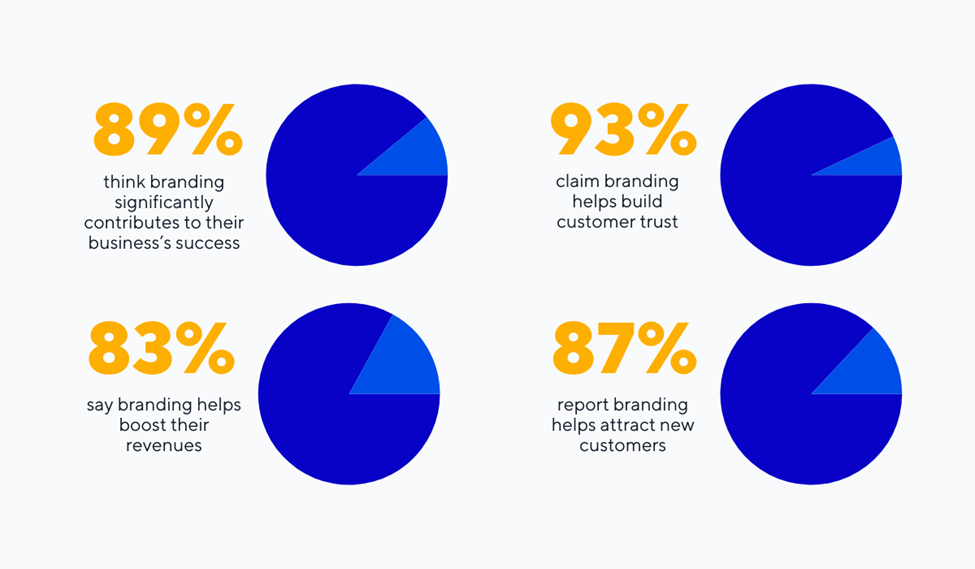
Illustration: Tablein / Data: 99designs
As illustrated, the survey findings vividly demonstrate the profound impact that a well-defined brand identity can have on various aspects of a restaurant’s success, including customer trust, revenue generation, and attracting new patrons.
Moreover, as online marketing has significantly reduced the attention span of prospective diners, good branding (along with great food and service) has become even more important.
For instance, ads inserted before a YouTube video starts give you only a few seconds to get your message across and convince the viewer to check out your restaurant.
So, what does it take to develop a solid brand identity?
Here are seven ways you can do so:

Illustration: Tablein / Data: Designhill
Let’s comment on a few of these for more clarity.
For example, strategies that help your restaurant create its identity may include all the online presence-building tips provided in this article, from an optimized website (covered next) to online advertising efforts.
When you apply these strategies, consistency is key.
More precisely, your restaurant’s brand identity must resonate across all channels—from your website and menu design to social media posts and customer service.
Similarly, your brand should reflect the priorities, values, and unique selling points of your establishment.
As for selling your brand and not your products or services, this goes back to the limited time people give to perceiving online ads.
In other words, once your brand gets their attention, you can elaborate on how exceptional your menu offer and service are on other online platforms.
In conclusion, crafting a compelling brand identity and ensuring its consistent presentation, both online and offline, serves as a powerful tool for making your restaurant stand out in the dynamic online landscape.
Optimize Your Website
Your restaurant’s website is very likely the first thing a prospective customer will check out if they’re interested in dining there.
Therefore, creating a visually appealing, functional, user-friendly website with clear navigation that matches your restaurant’s brand identity can help it stand out in the online space.
To underpin our argument, consider that, according to MGH’s survey, 68% of potential guests abandoned the idea of dining at a restaurant after checking out its website and 62% decided not to order takeout for the same reason.
Among the above-listed website design elements, it’s crucial to strike a balance where functionality takes precedence without overshadowing the importance of aesthetics.
In other words, when visiting your website, customers should easily find essential information, such as the menu, contact details, and operating hours.
To further optimize your establishment’s website and streamline a prospective diner’s experience, you should consider implementing a simple and easy-to-use restaurant reservation system.
For example, our table booking software widget, Tablein, offers a seamless solution.

Source: Tablein
For instance, customers who want to visit the above restaurant can simply click on the “reservations” tab, select the restaurant’s location (since they have two locations in the UK), and instantly book a table via Tablein.
First of all, this eliminates the need for phone calls or emails, thereby making your guests’ reservations via your website as simple as possible.
Second, this also saves your staff a lot of time and effort otherwise invested in handling table bookings.
Additionally, consider optimizing your website for search engines to improve its visibility as effective search engine optimization (SEO) strategies can significantly impact your restaurant’s Google rankings.
Here’s just a quick overview of some important SEO practices:
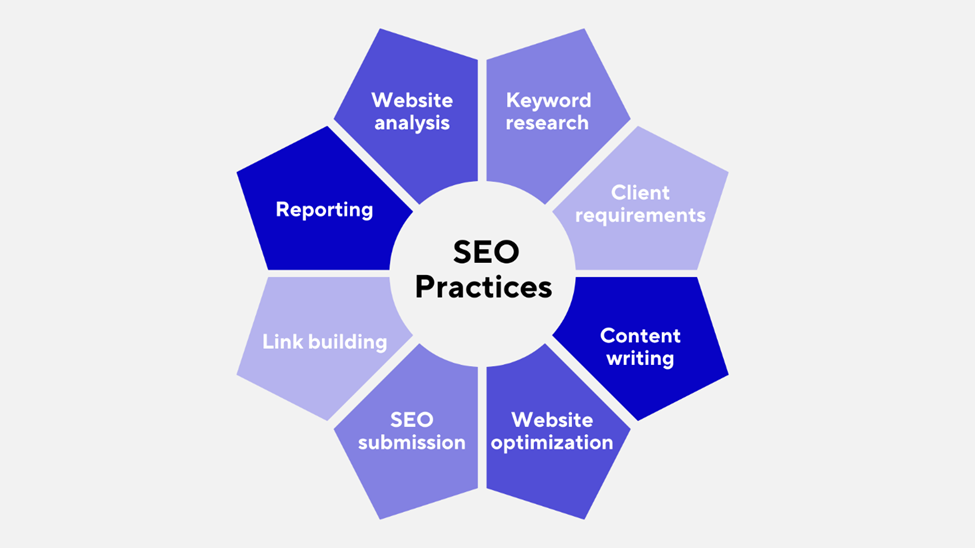
Illustration: Tablein / Data: Growth Hackers
In more practical terms, SEO involves your website:
- Having relevant keywords embedded into its content
- Ensuring easy viewing on mobile phones
- Encouraging customer reviews
- Being regularly updated with fresh content, such as new menu items, discount offers, and upcoming events
These practices can boost your site’s search engine rankings and engage visitors.
To recap, you want a website that seamlessly combines functionality, design, and content optimized for search engines.
Coupled with a convenient reservation system, this will not only attract potential diners but also streamline their entire dining experience, helping you set your restaurant apart in the competitive online landscape.
Build a Social Media Community
Establishing a social media presence on platforms like Facebook, X (formerly Twitter), and Instagram has proven to be an effective strategy for numerous restaurants aiming to elevate brand awareness and foster customer loyalty.
However, cultivating a community of actively engaged users—those who not only repost your content but also interact with your posts and share their own experiences—is easier said than done.
To begin, adopt a deliberate approach by selecting one or two social media platforms that align with your target audience.
If you’re unsure where to start or your restaurant has a broad audience, choose those platforms where you’re already active or that simply fit your preferences.
You can draw inspiration from social media profiles of other restaurants that have already built a substantial following, such as this New York-based Italian food restaurant.
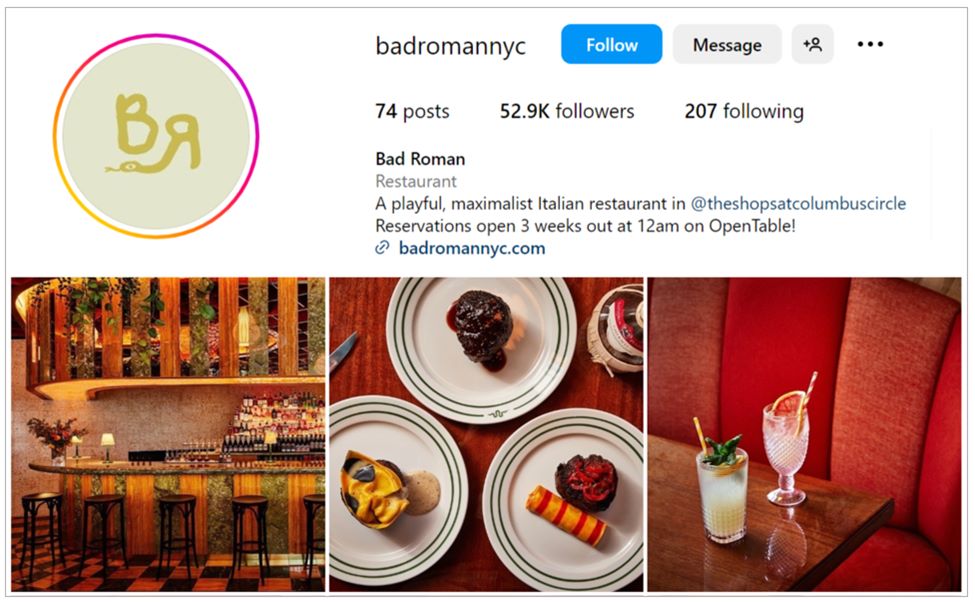
Source: Bad Roman on Instagram
Again, building a social media community is not just about increasing the number of followers and sharing nice photos of meals, but also actively engaging with your audience.
More precisely, true differentiation between your restaurant and all others you’re competing with comes from active engagement and relationship-building with your guests.
One way to do so and also attract new customers is through social media giveaways, as illustrated in this example.

Source: Four Elephants on X
Such giveaways can be a powerful technique to not only reward existing followers but also attract new ones.
By offering enticing incentives, you create a buzz around your restaurant, increasing both online and foot traffic.
Additionally, you can explore diverse engagement techniques such as interactive games, quizzes, and raffles.
These initiatives inject fun into your social media presence and encourage active participation from your audience, fostering a sense of community.
This also implies you’re ready to respond promptly to comments, ask questions, and encourage user-generated content to make your followers feel heard and valued.
Overall, leveraging social media platforms by posting user-engaging content is all about cultivating a thriving community that actively supports and promotes your restaurant, helping it stand out from the competition.
Set up a Google Business Profile
If you haven’t already done it, setting up a Google Business Profile is crucial for your restaurant’s local visibility when potential customers are searching for restaurants near them.
However, even if you have this critical profile, there are things you can do to optimize it for better results.
Start by ensuring that all the information on your profile is accurate and up-to-date.
This includes essential details such as your restaurant's name, address, phone number, business hours, and a link to your website.
This will help customers find you easily and also enhance your search engine rankings (local SEO).
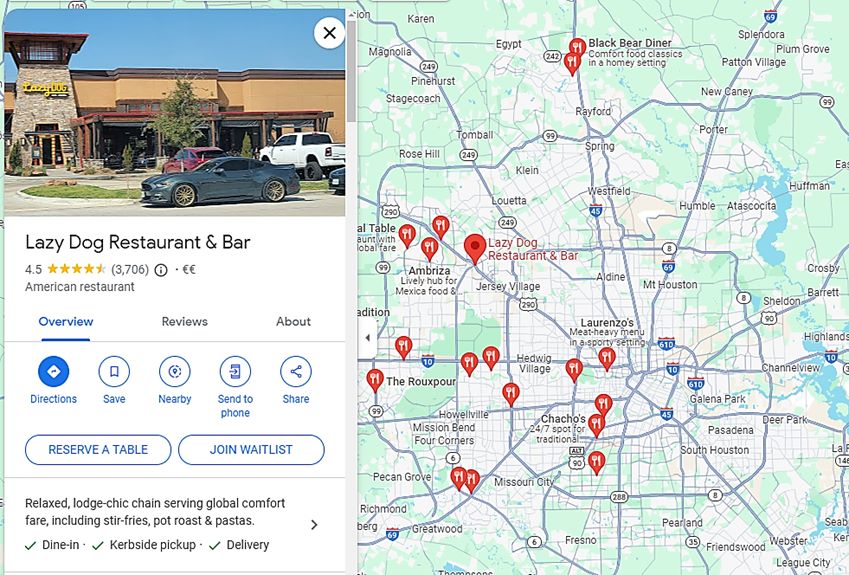
Source: Google
Your restaurant’s business profile acts as your free marketing page, so invest time to optimize as many details as possible, such as adding a direct link for online table reservations.
In addition to essential info, user reviews may be the most important component of your Google Business Profile.
Therefore, encourage satisfied customers to leave their positive reviews on your Google listing.
If any negative reviews show up, you can use your profile to address them promptly and professionally.
In doing so, respond to the reviewer with empathy, acknowledge their concerns, and offer a solution, such as a free or discounted meal if they return.
To recap, your Google Business Profile is a powerful and free tool, so setting it up and optimizing its details can have a profound effect on creating a positive online presence for your restaurant.
Start an Email Newsletter
Engaging your audience through a well-crafted email newsletter can be a potent strategy for making your restaurant stand out.
Although newsletters are predominantly used by large restaurant chains, there’s no reason why establishments with one or two venues couldn’t do the same.
To build a newsletter subscriber list, you can:
- Place a prominent sign-up form on your restaurant's website and offer incentives, such as a discount or some other perk, to encourage visitors to subscribe
- Include a newsletter subscription checkbox at the end of the online reservation process
- Leverage your social media platforms to promote the newsletter
- Use physical feedback forms or tablets at the register where guests can sign up for the newsletter
To illustrate, here’s an example.
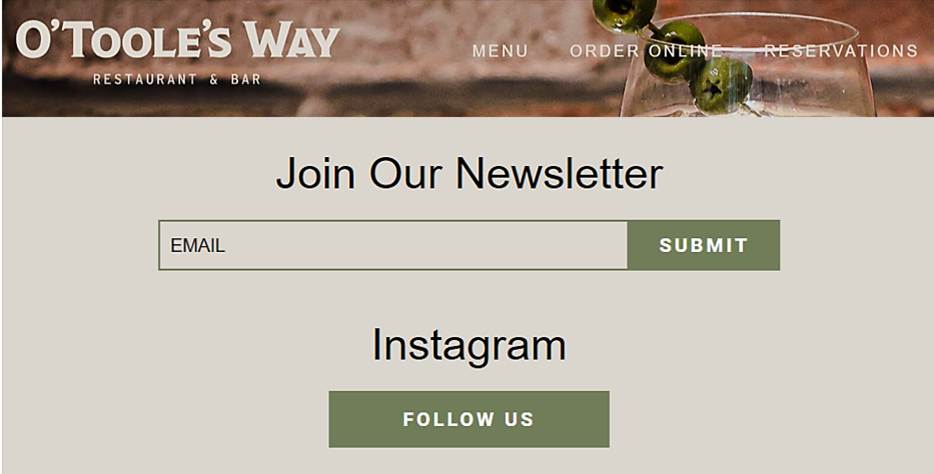
Source: O’Toole’s Way
As you can see, this restaurant also uses the opportunity to invite diners to follow them on Instagram.
With multiple sign-up options covered, you can use your newsletter to regularly update your customers with exclusive offers, new menu items, recipes from your chef, upcoming events, and more.
Also, you can use email automation tools to personalize them, thereby establishing a stronger connection with your audience.
Keep your newsletters easy to read, short, and visually captivating, enhancing the likelihood of drawing new and repeat customers to your restaurant.
Focus on seasonal promotions, food highlights, ingredients, and other updates to keep your audience informed and intrigued.
In summary, a compelling email newsletter can enhance customer engagement, keeping your restaurant top-of-mind, boosting brand awareness, and encouraging repeat visits.
Create a Blog
Starting a blog on your restaurant’s website can be an innovative way to give customers an inside look, thus helping you stand out among competitors.
For example, you can use blog posts to:
- Tell customers your restaurant’s origin story
- Share recipes and introduce new menu items
- Educate visitors about your (fresh and locally sourced) ingredients
- Provide behind-the-scenes insights
- Highlight special events
Whatever you choose to write (or have written on your behalf), well-crafted and engaging blogs can enhance your connection with existing and prospective guests.
Here is how the restaurant Upper Crust Pizza in Santa Fe, New Mexico does it.

Source: Upper Crust Pizza
Moreover, since each blog article becomes a new content page on your website, this can boost your search engine rankings, allowing you to show up higher when people search for restaurants online.
This improved visibility can attract more organic traffic to your website and, consequently, to your restaurant.
Additionally, the blog serves as an ongoing narrative, a channel for your restaurant's unique voice, where you can showcase your culinary expertise and build a community around your brand.
So, consider starting your restaurant's blog as a storytelling way to boost your online presence.
Invest in Online Advertising
Investing in targeted online advertising is a strategic move for restaurants aiming to amplify their online visibility.
Therefore, you can leverage platforms like Google Ads and other social media (Facebook Ads, Instagram Ads, etc.) to advertise to the right audience, boost your online presence, and, ultimately, bring more people through your restaurant’s doors.

Source: Google Ads
Utilizing geotargeting and other detailed targeting options available on these platforms ensures that your advertisements are specifically tailored to attract local patrons, maximizing the impact of your marketing efforts.
Furthermore, you can use pay-per-click (PPC) marketing to rank above your competitors in Google and other search engines’ results.
With targeted ads, you can showcase promotions, new menu items, and unique selling points precisely to your intended audience.
In summary, strategic investment in well-optimized online advertising can prove to be a cost-effective way to capture the attention of potential diners in your local area and beyond.
Conclusion
Generally, the tips provided in this article could be divided into “must-have” and “nice-to-have” groups.
The must-haves would include building your restaurant’s brand identity, optimizing the website, leveraging social media, and setting up a Google Business Profile while the remaining three (newsletter, blog, advertising) would fall under nice-to-haves.
By incorporating the essentials and considering additional options, you can create a well-rounded digital approach.
To streamline these efforts, explore innovative software tools designed for the restaurant industry.
Get a 30-day Exclusive Trial
As a Tablein blog reader, you’re eligible for an exclusive 30-day free trial to experience our simple reservation solution for your restaurant.
Enter your business email, and we’ll send you all the steps needed to create your account.
Share this
You may also like

Different Restaurant Reservations Channels You Can Use

7 Best Restaurant Marketing Strategies to Know and Use
